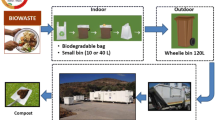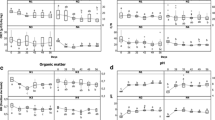Abstract
This study aimed to monitor the composting process of the first small-scale segregated bio-waste composting scheme in Jordan to divert different types of organic wastes and to evaluate the final product quality, which can be recovered and used as compost. In this study, four experimental windrow piles were first initiated and temporally monitored. The composting process was monitored against temperature, moisture and oxygen content, indicating that the biological conditions were sufficiently developed. The monitored experimental process showed overall decreasing profiles versus composting time for moisture, organic carbon and carbon/nitrogen content, as well as overall increasing profiles for electrical conductivity and total nitrogen, which represented qualitative indications of progress in the process. The product quality was examined and assessed against the quality specifications of EU End of Waste Criteria for bio-waste, which has been subjected to composting, aiming to specify whether the different types of organic wastes that have undergone recovery cease to be waste and can be classified as high quality compost. More specifically, on the one hand the heavy metal concentrations (Cr, Cu, Ni, Cd, Pb, Zn and Hg) were within the set limits and much lower compared to the European standards. On the other hand, compost respiration in the samples varied from 3.6 to 15.3 mgO2/g dm, which, in turn, indicates that all the compost samples appeared to be stable and rated as class IV and V final products.















Similar content being viewed by others
References
Haug, R.: The Practical Handbook of Compost Engineering. CRC Press, Boca Raton (1993)
El-Sayed, K.: Some physical and chemical properties of compost. Int. J. Waste Resour. 5(1), (2015). https://doi.org/10.4172/2252-5211.1000172
Chang, C.H., Chen, I.C., Yang, S.S.: Methane and carbon dioxide emissions from different composting periods. Terr. Atmos. Ocean. Sci. 20, 511–520 (2009)
Aspray, T.J., Dimambro, M.E., Wallace, P., Howell, G., Frederickson, J.: Static, dynamic and inoculum augmented respiration based test assessment for determining in-vessel compost stability. Waste Manage. 42, 3–9 (2015)
Agnew, J.M., Leonard, J.J., Feddes, J., Feng, Y.: A: modified air pycnometer for compost air volume and density determination. Can. Biosyst. Eng. 45, 6–27 (2003)
Orthodoxou, D., Pettitt, T.R., Fuller, M., Newton, M., Knight, N., Smith, S.R.: An investigation of some critical physico-chemical parameters influencing the operational rotary in-vessel composting of food waste by a small-to-medium sized enterprise. Waste Biomass Valoriz. 6(3), 293–302 (2015)
Benito, M., Masaguer, A., Moliner, A., Arrigo, N., Palma, R.M.: Chemical and microbiological parameters for the characterization of stability and maturity of pruning waste compost. Biol. Fert. Soils 37, 184–189 (2003)
Hoitink, H.A., Stone, A.G., Han, D.Y.: Suppression of plant diseases by composts. HortScience 32, 184–187 (1997)
Atiyeh, R.M., Edwards, C.A., Subler, S., Metzger, J.D.: Pig manure vermicompost as component of a horticultural bedding plant medium: effects on physicochemical properties and plant growth. Bioresour. Technol. 78, 11–20 (2001)
He, X., Logan, T.J., Traina, S.J.: Physical and chemical characteristics of selected US municipal solid waste composts. J. Environ. Qual. 24, 543–552 (1995)
Hurerta-Pujol, O., Soliva, M., Martinez-Farre, F.X., Valero, J., Lopez, M.: Bulk density determination as a simple and complementary tool in composting process control. Bioresour. Technol. 101, 995–1001 (2010)
Benito, M., Masaguer, A., Moliner, A., De Antonio, R.: Use of pruning waste compost as a component in soilless growing media. Bioresour. Technol. 97, 2071–2076 (2005)
Michel, F., Graeber, D., Forney, L., Reddy, C.: The fate of lawn care pesticides during composting. Biocycle 37(3), 64–66 (1996)
Rynk, R., van de Kamp, M., Willson, G., Singley, M., Richard, T., Kolega, J., Gouin, F., Laliberty, L., Kay, D., Murphy, D., Hoitink, H., Brinton, W.: On-Farm Composting Handbook, Ithaca: Natural Resource, Agriculture, and Engineering Service (NRAES). (1992)
Ryan, J., Astafan, J., Rashid, A.: Soil and Plant Analysis Laboratory Manual, 2nd edn., International Center of Agricultural Research in Dry Areas, (ICARDA), Aleppo (2003)
APHA, American Public Health Association: Standard Methods for Examination of Water and Wastewater. 23 edn., WWA, Washington, D.C. (2005)
Mercer, W., Rose, W.: Investigation of Windrow Composting as a Means for Disposal of Fruit Waste Solid. National Canners Association Research Foundation, Washington, DC (1968)
Artola, A., Barrena, R., Font, X., Gabriel, D., Gea, T., Mudhoo, A., Sánchez, A.: Composting from a sustainable point of view: respirometric indices as key parameter. Dyn. Soil Dyn Plant (Global Science books) 3, 1–16 (2009)
Elmaslar-Özbaş, E., Balkaya, N.: Extraction of heavy metals from compost using a mixture of Na2EDTA and Na2S2O5: column studies. J. Soil Sci. Plant Nutr. 12(3), 525–534 (2012)
Amlinger, F., Peyr, S., Müsken, J.: State of the art of Composting. Environment and Water Management and Compost—Development & Consulting, Directive_202 Compost: P103. (2005)
Olsen, S., Cole, C., Watanabe, F., Dean, L.: Estimation of available phosphorus in soils by extraction with sodium bicarbonate. USDA Circular No. 939. (1954)
Abbassi, B.: Co-composting of olive mill solid waste with chicken manure. J. Solid Waste Technol. Manag. 34(4), 191–197 (2008)
Graves, R., Hattemer, G., Stettler, D.: Composting. Chapter 2, Part 637. Environmental Engineering National Engineering Handbook, USDA Natural Resources Conservation Service. (2000)
Smith, SR., Jasim, S.: Small-scale home composting of biodegradable household waste: overview of key results from a 3-year research programme in West London. Waste Manag. Res. 27, 941–950 (2009)
WSU, Washington State University.: Compost Fundamentals database, http://whatcom.wsu.edu/ag/compost/fundamentals/needscarbon nitrgen.htm. (2007). Accessed 17 Apr 2016
USEPA, United States Environmental Protection Agency: Composting of Municipal Wastewater Sludges. EPA/625/4–85-016. Office of Wastewater Management, Cincinnati. (1985)
Tchobanoglous, G., Theisen, H., Vigil, S.: Biological and chemical conversion technologies: 671–716. In: Tchobanoglous, G. (ed.) Integrated Solid Waste Management: Engineering Principles and Management Issues, 2nd edn. McGraw-Hill Higher Education, New York (1993)
Lynch, N., Cherry, R.: Winter composting using the passively aerated windrow system. Compost Sci. Utilization 4(3), 44–52 (1996)
Dougherty, M.: Field Guide to On-Farm Composting. Natural Resource. Agriculture, and Engineering Service (NRAES), Ithaca (1999)
Haug, R.: Composting process design criteria. BioCycle 27, 53–57 (1986)
Willson, G.: Combining raw materials for composting: 102–105. In: Goldstein, J. (ed.) The Biocycle Guide to Yard Waste Composting. The JG Press, Emmaus (1993)
CIWMB: Compost use for landscape and environmental enhancement, California Environmental Protection Agency, the California Integrated Waste Management Board, USA. (2007)
USCC: Field guide to compost use, the US composting council, E&A Environmental Consultants, Inc., USA. (2001)
Poincelet, R.: The biochemistry of composting, p. 33–39. In: Composting of Municipal Sludges and Wastes. Proceedings of the National Conference, Rockville, Maryland. (1977)
Brinton, W.F.: Compost quality standards & guidelines, final report. Woods End R Laboratory, Inc. (2000)
Bombatkar, V.: The Miracle Called Compost. The Other India Press, Pune (1996)
Ouédraogo, E., Mando, A., Zombré, N.P.: Use of compost to improve soil properties and crop productivity under low input agricultural system in West Africa. J. Agric. Ecosyst. Environ. 84, 259–266 (2001)
Yue, B., Chen, T., Gao, D., Zheng, G., Liu, B., Lee, D.: Pile settlement and volume reduction measurement during forced-aeration static composting. Patent of PR China, Biores. Technol. 99, 7450–7457 (2008)
Mustin, M.: Le Compost gestion de la matière organique, p. 953. Editions François Dubusc, Paris (1987)
Richard, T.L.: Municipal solid waste composting: physical and biological processing. Biomass Bioenerg. 3, 163–180 (1992)
Hogg, D., Favoino, E., Centemero, M., Caimi, V., Amlinger, F., Devliegher, W., Brinton, W., Antler, S.: Comparison of compost standards within the EU, North America and Australia, The Waste and Resources Action Programme (WRAP), Oxon. ISBN 1-84405-003-3. (2002)
Bhattacharyya, P., Chakrabarti, K., Chakraborty, A., Bhattacharya, B.: Characterization of municipal solid waste compost in relation to maturity, stability and heavy metals content and pathogens. Indian J. Agri. Sci. 71, 791–793 (2001)
Papadimitrou, E.K., Barton, J.R., Stentiford, E.I.: Sources and levels of potentially toxic elements in the biodegradable fraction of autoclaved non-segregated household waste and its compost/digestate. Waste Manag. Res. 26, 419–430 (2008)
Wei, Y., Li, J., Shi, D., Liu, G., Zhao, Y., Shimaoka, T.: Environmental challenges impeding the composting of biodegradable municipal solid waste: a critical review. Resour. Conserv. Recycl. 122, 51–65 (2017)
Veeken, A., Hamelers, B.: Sources of Cd, Cu, Pb and Zn in biowaste. Sci. Total Environ. 30, 87–98 (2002)
Komilis, D.B., Ham, R.K.: The effect of lignin and sugars to the aerobic decomposition of solid wastes. Waste Manag. 23, 419–423 (2003)
Tiquia, S.M.: Microbiological parameters as indicators of compost maturity. J. Appl. Microbiol. 99, 816–828 (2005)
Gea., T., Ferrer, P., Alvaro, G., Valero, F., Artola, A., Sánchez, A.: Co-composting of sewage sludge: fats mixtures and characteristics of the lipases involved. Biochem. Eng. J. 33(3), 275–283 (2007)
Barrena, R., Vázquez, F., Sánchez, A.: Dehydrogenase activity as a method for monitoring the composting process. Biores. Technol. 99(4), 905–908 (2008)
Kehres, B.: Method book for the analysis of compost “Methodenbuch zur Analyse von Kompost”. In: Bundesgütegemeinschaft Kompost e.V. Red. 4., erg. Und überarb. Aufl. Verl. Abfall Now, Stuttgart (1998)
Wu, L., Ma, L., Martinez, G.: Comparison of methods for evaluating stability and maturity of biosolids compost. J. Environ. Qual. 27, 424–429 (2000)
Garcia, C., Hernandez, T., Costa, F., Pascual, J.: Phytotoxicity due to the agricultural use of urban wastes: germination experiments. J. Sci. Food Agric. 59, 313–319 (1992)
Acknowledgements
The research experiments, with an annual capacity of 400 m3, were conducted on an established composting pilot plant, which is located at the Al-Ghabawi landfill site around 40 km east of Amman, Jordan. This project was carried out over 1 year, from June 2016. It was funded by DEG Deutsche Investitions-und Entwicklungsgesellschaft mbH and Hydroplan Ingenieur- Gesellschaft mbH through the framework of the Jordanian Government’s Public Private Partnership (PPP) Projects and implemented by the Greater Amman Municipality (GAM), Hydroplan GmbH and its Jordanian private partner (Mustafa Al Jaar Establishment for Consultation), Jordan.
Author information
Authors and Affiliations
Corresponding author
Rights and permissions
About this article
Cite this article
Hemidat, S., Jaar, M., Nassour, A. et al. Monitoring of Composting Process Parameters: A Case Study in Jordan. Waste Biomass Valor 9, 2257–2274 (2018). https://doi.org/10.1007/s12649-018-0197-x
Received:
Accepted:
Published:
Issue Date:
DOI: https://doi.org/10.1007/s12649-018-0197-x




